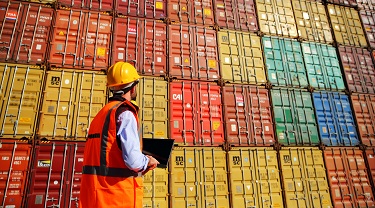2022 was supposed to be different, to be welcomed with cautious optimism. We envisioned a global economy firmly on its recovery trajectory, and risk stabilizing, albeit at a higher level. Instead, the first quarter of this year has been dominated by the conflict in Ukraine, with shockwaves felt far and wide.
One tends to think of country risk primarily as it relates to emerging markets, where institutional effectiveness, policy predictability and fiscal positions tend to be weaker. However, it’s now Europe that’s most directly impacted by the conflict in Ukraine.
In its April report, the International Monetary Fund (IMF) forecasts the Euro area to grow by less than 3% and closer to 2% next year, a material downgrade from January’s outlook. As the conflict drags into its third month without a resolution in sight, the impacts extend beyond growth to include inflation, exchange rate volatility and government interest payments, all components of EDC Economics’ short-term rating. Complicating the outlook further are rising interest rates, which will make financing pricier, and a China beset by economically damaging COVID-19 lockdowns.
Russia’s invasion of Ukraine is an anomaly; the trend in inter-state conflict had been one of significant decline in recent decades with most of the conflicts focused on warring parties within a state. EDC Economics’ ratings include political violence, which measures the likelihood over a five-year horizon of an act of political violence occurring in a country that could have a significant impact on the country's commercial environment.
The conflict in Ukraine means higher political violence risk for Russia, Belarus, and Ukraine, and increased risk for neighbouring Eastern European states such as Poland and those in the Baltics and around the Black Sea. Our base-case scenario is that the conflict won’t spillover into another country, but the situation remains volatile and fluid.
You should also check out
EDC interactive tool offers economic insights on Canada’s Top 75 trading partners.
Beyond the external threat component, our political violence methodology looks at other forward-looking internal indicators, like infant mortality rates and state capacity; both of which are likely to be negatively affected as food and fuel prices skyrocket.
In March, the United Nation’s food price index hit a record level and was 17% higher than at the start of the Arab Spring in 2010. Oil prices are around 50% higher than last year’s average price. The World Bank estimates that the pandemic and the conflict will together lead to an additional 75 million to 95 million people living in extreme poverty in 2022 compared to previous projections.
For some emerging markets that are still reeling from the post-pandemic economic and fiscal hangover and are net commodity importers, this geopolitical shock may lead to social unrest. With the cost of living rising, protests have already broken out in countries from Peru to Mauritius.
The external backdrop will also put downward pressure on the sovereign probability of default risk by exacerbating pre-existing structural weaknesses. In Sri Lanka, for example, the global price shock—piled on top of its economic mismanagement—has forced the country to suspend payment to external creditors. More than half of the close to 200 sovereigns that EDC Economics rates are now in either the medium-high or high-risk categories, slightly less than the proportion classified as being in “debt distress” by the World Bank. With interest rates rising sharply, capital flows heading back to the United States and slower global growth projected, some emerging markets are in hot water.
Many face cyclical challenges and structural issues, too. Public-debt ratios across middle-income economies now stand at record highs, and indebtedness in the poorest countries has risen toward levels not seen since the 1990s. Geopolitics is also straining global trade, which poorer countries depend on.
The bottom line?
While the conflict in Ukraine began at the end of February, we’re only now witnessing its initial impact on country risk ratings. Given the macro-financial and political consequences of the conflict, we can expect an increase in rating downgrades as the year progresses. Keep abreast of the latest developments through the EDC’s Country Risk Quarterly, an interactive tool that offers timely information of 50 countries.
This week, a very special thank you to Daniel Benatuil, senior economist, EDC Economics. The Weekly Commentary returns May 26.
As always, at EDC Economics, we value your feedback. If you have ideas for topics that you would like us to explore, please email us at economics@edc.ca and we’ll do our best to cover them.
This commentary is presented for informational purposes only. It’s not intended to be a comprehensive or detailed statement on any subject and no representations or warranties, express or implied, are made as to its accuracy, timeliness or completeness. Nothing in this commentary is intended to provide financial, legal, accounting or tax advice nor should it be relied upon. EDC nor the author is liable whatsoever for any loss or damage caused by, or resulting from, any use of or any inaccuracies, errors or omissions in the information provided.




